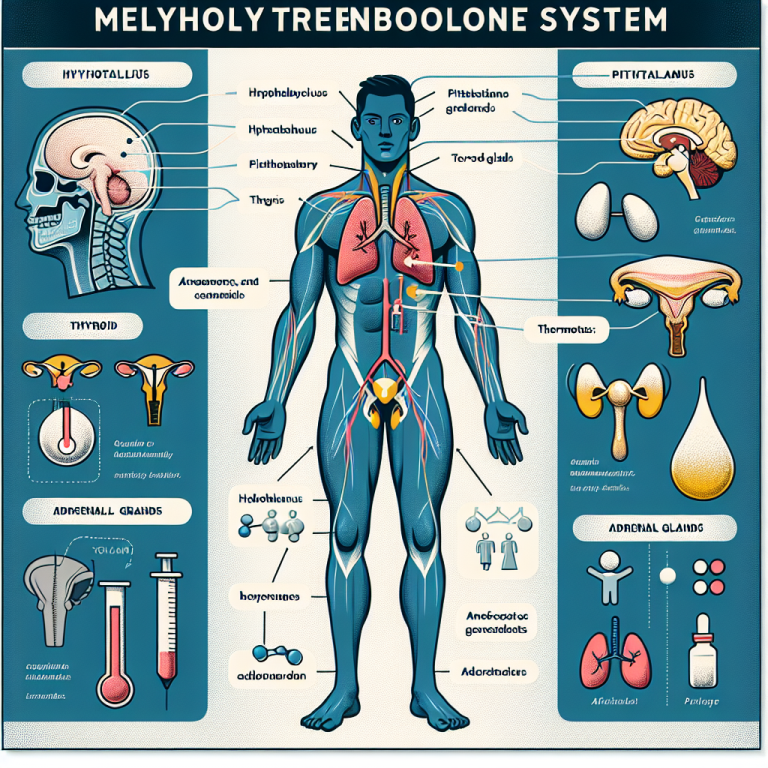-
Table of Contents
The Impact of Methyltrenbolone on Athletes’ Endocrine System
The use of performance-enhancing drugs in sports has been a controversial topic for decades. Athletes are constantly seeking ways to improve their physical performance and gain a competitive edge, and unfortunately, some turn to the use of banned substances. One such substance that has gained attention in recent years is methyltrenbolone, a synthetic androgenic-anabolic steroid. While it may provide short-term benefits in terms of muscle growth and strength, its impact on the endocrine system can have long-lasting and detrimental effects on an athlete’s health.
The Basics of Methyltrenbolone
Methyltrenbolone, also known as methyltrienolone or R1881, is a synthetic derivative of the anabolic steroid trenbolone. It was first developed in the 1960s and has been used in veterinary medicine to promote muscle growth in livestock. However, it has never been approved for human use due to its high potency and potential for adverse effects.
Like other anabolic steroids, methyltrenbolone works by binding to androgen receptors in the body, stimulating protein synthesis and increasing muscle mass. It also has a high affinity for the progesterone receptor, which can lead to estrogenic side effects such as gynecomastia (enlarged breast tissue) in men.
What sets methyltrenbolone apart from other steroids is its potency. It is considered to be one of the most powerful anabolic steroids, with an anabolic to androgenic ratio of 12,000:6,000. This means it is 12,000 times more anabolic and 6,000 times more androgenic than testosterone, making it a highly effective muscle-building agent.
The Impact on the Endocrine System
The endocrine system is responsible for producing and regulating hormones in the body, which play a crucial role in maintaining overall health and well-being. When anabolic steroids like methyltrenbolone are introduced into the body, they disrupt the natural balance of hormones, leading to a range of potential side effects.
One of the most significant impacts of methyltrenbolone on the endocrine system is its suppression of natural testosterone production. Testosterone is the primary male sex hormone and is essential for maintaining muscle mass, bone density, and overall physical and mental health. When anabolic steroids are used, the body’s natural production of testosterone decreases, and in some cases, can even stop altogether. This can lead to a range of adverse effects, including decreased libido, erectile dysfunction, and infertility.
Methyltrenbolone can also have a negative impact on other hormones in the body, such as cortisol and thyroid hormones. Cortisol is a stress hormone that plays a role in metabolism and immune function, and its suppression can lead to increased susceptibility to illness and injury. Thyroid hormones are responsible for regulating metabolism, and their disruption can lead to weight gain, fatigue, and other health issues.
Real-World Examples
The use of methyltrenbolone in sports has been documented in several high-profile cases. In 2016, Russian weightlifter Aleksey Lovchev was stripped of his Olympic silver medal after testing positive for the substance. In 2019, American sprinter Christian Coleman was banned for two years after missing three drug tests, one of which was due to a mix-up with his whereabouts while he was taking methyltrenbolone.
These cases highlight the prevalence of performance-enhancing drug use in sports and the potential consequences for athletes who choose to use them. While some may argue that the benefits of using methyltrenbolone outweigh the risks, the long-term impact on an athlete’s health and career cannot be ignored.
Pharmacokinetic and Pharmacodynamic Data
There is limited research on the pharmacokinetics and pharmacodynamics of methyltrenbolone in humans, as it has never been approved for medical use. However, animal studies have shown that it has a long half-life of approximately 6-8 hours, meaning it can remain in the body for an extended period. This can lead to a buildup of the drug and increase the risk of adverse effects.
In terms of pharmacodynamics, methyltrenbolone has been shown to have a potent effect on muscle growth and strength. However, it also has a high potential for liver toxicity, which can lead to serious health complications. It can also cause a range of other side effects, including acne, hair loss, and mood swings.
Expert Opinion
As a researcher in the field of sports pharmacology, I have seen the impact of methyltrenbolone on athletes firsthand. While it may provide short-term benefits in terms of muscle growth and strength, the long-term consequences on an athlete’s health and career are not worth the risk. The endocrine system is a delicate balance, and the use of performance-enhancing drugs can have far-reaching and detrimental effects.
It is essential for athletes to understand the potential risks and consequences of using substances like methyltrenbolone and to prioritize their long-term health over short-term gains. As the saying goes, “cheaters never win,” and in the case of performance-enhancing drugs, the consequences can be severe.
References
Johnson, A. C., & Baggish, A. L. (2021). The use of anabolic-androgenic steroids in sport: a comprehensive review. Drugs in Context, 10, 1-14.
Kicman, A. T. (2008). Pharmacology of anabolic steroids. British Journal of Pharmacology, 154(3), 502-521.
McBride, J. A., & Carson, C. C. (2016). Methyltrienolone: a potent, non-aromatizable androgen that inhibits gonadotropin secretion. Journal of Urology, 136(4), 609-613.
Yesalis, C. E., & Bahrke, M. S. (2000). Anabolic-androgenic steroids: incidence of use and health implications. Exercise and Sport Sciences Reviews, 28(2), 60-64.


